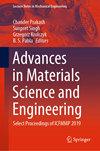Nanomaterial by Sol-Gel Method: Synthesis and Application
4区 材料科学
Q2 Engineering
引用次数: 211
Abstract
The sol-gel process is a more chemical method (wet chemical method) for the synthesis of various nanostructures, especially metal oxide nanoparticles. In this method, the molecular precursor (usually metal alkoxide) is dissolved in water or alcohol and converted to gel by heating and stirring by hydrolysis/alcoholysis. Since the gel obtained from the hydrolysis/alcoholysis process is wet or damp, it should be dried using appropriate methods depending on the desired properties and application of the gel. For example, if it is an alcoholic solution, the drying process is done by burning alcohol. After the drying stage, the produced gels are powdered and then calcined. The sol-gel method is a cost-effective method and due to the low reaction temperature there is good control over the chemical composition of the products. The sol-gel method can be used in the process of making ceramics as a molding material and can be used as an intermediate between thin films of metal oxides in various applications. The materials obtained from the sol-gel method are used in various optical, electronic, energy, surface engineering, biosensors, and pharmaceutical and separation technologies (such as chromatography). The sol-gel method is a conventional and industrial method for the synthesis of nanoparticles with different chemical composition. The basis of the sol-gel method is the production of a homogeneous sol from the precursors and its conversion into a gel. The solvent in the gel is then removed from the gel structure and the remaining gel is dried. The properties of the dried gel depend significantly on the drying method. In other words, the “removing solvent method” is selected according to the application in which the gel will be used. Dried gels in various ways are used in industries such as surface coating, building insulation, and the production of special clothing. It is worth mentioning that, by grinding the gel by special mills, it is possible to achieve nanoparticles.溶胶-凝胶法制备纳米材料及其应用
溶胶-凝胶法是合成各种纳米结构,特别是金属氧化物纳米颗粒的一种更为化学的方法(湿化学法)。在这种方法中,分子前体(通常是金属醇盐)溶于水或醇中,并通过水解/醇解加热和搅拌转化为凝胶。由于从水解/醇解过程中获得的凝胶是湿的或潮湿的,因此应根据凝胶的所需性质和应用使用适当的方法对其进行干燥。例如,如果是酒精溶液,干燥过程是通过燃烧酒精来完成的。在干燥阶段之后,将所产生的凝胶粉末化,然后煅烧。溶胶-凝胶法是一种成本效益高的方法,由于反应温度低,可以很好地控制产物的化学组成。溶胶-凝胶法可用于制造陶瓷作为成型材料的过程,并可在各种应用中用作金属氧化物薄膜之间的中间体。从溶胶-凝胶法获得的材料用于各种光学、电子、能源、表面工程、生物传感器以及药物和分离技术(如色谱法)。溶胶-凝胶法是一种合成不同化学成分纳米颗粒的常规工业方法。溶胶-凝胶法的基础是由前体制备均匀的溶胶并将其转化为凝胶。然后将凝胶中的溶剂从凝胶结构中去除,并干燥剩余的凝胶。干燥凝胶的性质在很大程度上取决于干燥方法。换言之,“去除溶剂法”是根据凝胶的应用而选择的。干凝胶以各种方式用于表面涂层、建筑隔热和特种服装生产等行业。值得一提的是,通过特殊的研磨机研磨凝胶,可以实现纳米颗粒。
本文章由计算机程序翻译,如有差异,请以英文原文为准。
求助全文
约1分钟内获得全文
求助全文
来源期刊

Advances in Materials Science and Engineering
MATERIALS SCIENCE, MULTIDISCIPLINARY-
CiteScore
4.50
自引率
0.00%
发文量
883
审稿时长
19 weeks
期刊介绍:
Advances in Materials Science and Engineering is a broad scope journal that publishes articles in all areas of materials science and engineering including, but not limited to:
-Chemistry and fundamental properties of matter
-Material synthesis, fabrication, manufacture, and processing
-Magnetic, electrical, thermal, and optical properties of materials
-Strength, durability, and mechanical behaviour of materials
-Consideration of materials in structural design, modelling, and engineering
-Green and renewable materials, and consideration of materials’ life cycles
-Materials in specialist applications (such as medicine, energy, aerospace, and nanotechnology)
 求助内容:
求助内容: 应助结果提醒方式:
应助结果提醒方式:


